Monitoring Indoor Air Quality in Classrooms Using Low-Cost Sensors: Does the Perception of Teachers Match Reality?
Abstract
:1. Introduction
2. Materials and Methods
2.1. Study Site
2.2. IAQ Monitoring Equipment Based on Low-Cost Sensors
2.3. IAQ and Perception Survey During Classes
2.4. Data and Statistical Analysis
2.5. Exposure to PM and the Doses Inhaled by Students
3. Results
3.1. Indoor Air Quality Parameters
3.1.1. Temperature
3.1.2. Relative Humidity
3.1.3. Carbon Dioxide
3.1.4. Total Volatile Organic Compounds
3.1.5. Particulate Matter
3.2. Indoor Air Quality Perception
3.3. Spearman’s Correlation Between IAQ Perception and Environmental Parameters
4. Discussion
- (i)
- IAQ perception focused on the teachers’ perceptions and not on the students’ perspectives, which should also be evaluated. Considering that students tend to feel comfortable in indoor climates that are cooler than environments where adults feel thermally neutral [3], it would be relevant to assess their perceptions and identify potential associations with environmental parameters.
- (ii)
- This type of study should be performed throughout the academic year to understand the influence of seasons on IAQ perception and IAQ parameters (including ventilation).
- (iii)
- The impact of different ventilation typologies in the classrooms (natural and mechanical) on IAQ perception and IAQ levels should be studied.
- (iv)
- To evaluate the effective impact of an IAQ awareness campaign for teachers and students on the improvement or not of IAQ levels during classes and their perception.
- (i)
- Ventilate the classrooms between classes by opening doors and windows during breaks (to avoid pollutant accumulation from one class to the next);
- (ii)
- Classrooms should be cleaned at the end of the day instead of in the morning before classes so that the decay of pollutants (particles and VOCs) can occur during nighttime;
- (iii)
- If outdoor meteorological conditions allow, always have some ventilation during classes by opening windows and/or doors.
5. Conclusions
Supplementary Materials
Author Contributions
Funding
Institutional Review Board Statement
Informed Consent Statement
Data Availability Statement
Conflicts of Interest
References
- Pulimeno, M.; Piscitelli, P.; Colazzo, S.; Colao, A.; Miani, A. Indoor Air Quality at School and Students’ Performance: Recommendations of the UNESCO Chair on Health Education and Sustainable Development & the Italian Society of Environmental Medicine (SIMA). Health Promot. Perspect. 2020, 10, 169–174. [Google Scholar] [CrossRef] [PubMed]
- Salthammer, T.; Uhde, E.; Schripp, T.; Schieweck, A.; Morawska, L.; Mazaheri, M.; Clifford, S.; He, C.; Buonanno, G.; Querol, X.; et al. Children’s Well-Being at Schools: Impact of Climatic Conditions and Air Pollution. Environ. Int. 2016, 94, 196–210. [Google Scholar] [CrossRef] [PubMed]
- Sadrizadeh, S.; Yao, R.; Yuan, F.; Awbi, H.; Bahnfleth, W.; Bi, Y.; Cao, G.; Croitoru, C.; de Dear, R.; Haghighat, F.; et al. Indoor Air Quality and Health in Schools: A Critical Review for Developing the Roadmap for the Future School Environment. J. Build. Eng. 2022, 57, 104908. [Google Scholar] [CrossRef]
- Faria, T.; Martins, V.; Correia, C.; Canha, N.; Diapouli, E.; Manousakas, M.; Eleftheriadis, K.; Almeida, S.M. Children’s Exposure and Dose Assessment to Particulate Matter in Lisbon. Build. Environ. 2020, 171, 106666. [Google Scholar] [CrossRef]
- Kumar, P.; Singh, A.B.; Arora, T.; Singh, S.; Singh, R. Critical Review on Emerging Health Effects Associated with the Indoor Air Quality and Its Sustainable Management. Sci. Total Environ. 2023, 872, 162163. [Google Scholar] [CrossRef]
- Osborne, S.; Uche, O.; Mitsakou, C.; Exley, K.; Dimitroulopoulou, S. Air Quality around Schools: Part I—A Comprehensive Literature Review across High-Income Countries. Environ. Res. 2021, 196, 110817. [Google Scholar] [CrossRef] [PubMed]
- Daisey, J.M.; Angell, W.J.; Apte, M.G. Indoor Air Quality, Ventilation and Health Symptoms in Schools: An Analysis of Existing Information. Indoor Air 2003, 13, 53–64. [Google Scholar] [CrossRef] [PubMed]
- Luther, M.B.; Horan, P.; Tokede, O. Investigating CO2 Concentration and Occupancy in School Classrooms at Different Stages in Their Life Cycle. Archit. Sci. Rev. 2018, 61, 83–95. [Google Scholar] [CrossRef]
- Fu, N.; Wei, P.; Jia, Y.; Zheng, X.; Guan, J. Indoor Volatile Organic Compounds in Densely Occupied Education Buildings of Four Universities: Target List, Concentration Levels and Correlation Analysis. Build. Environ. 2021, 191, 107599. [Google Scholar] [CrossRef]
- Son, Y.-S. A Review on Indoor and Outdoor Factors Affecting the Level of Particulate Matter in Classrooms of Elementary Schools. J. Build. Eng. 2023, 75, 106957. [Google Scholar] [CrossRef]
- Fisk, W.J. The Ventilation Problem in Schools: Literature Review. Indoor Air 2017, 27, 1039–1051. [Google Scholar] [CrossRef] [PubMed]
- Wargocki, P.; Porras-Salazar, J.A.; Contreras-Espinoza, S.; Bahnfleth, W. The Relationships between Classroom Air Quality and Children’s Performance in School. Build. Environ. 2020, 173, 106749. [Google Scholar] [CrossRef]
- Toyinbo, O. Indoor Environmental Quality, Pupils’ Health, and Academic Performance—A Literature Review. Buildings 2023, 13, 2172. [Google Scholar] [CrossRef]
- Saraga, D.Ε.; Querol, X.; Duarte, R.M.B.O.; Aquilina, N.J.; Canha, N.; Alvarez, E.G.; Jovasevic-Stojanovic, M.; Bekö, G.; Byčenkienė, S.; Kovacevic, R.; et al. Source Apportionment for Indoor Air Pollution: Current Challenges and Future Directions. Sci. Total Environ. 2023, 900, 165744. [Google Scholar] [CrossRef]
- Becerra, J.A.; Lizana, J.; Gil, M.; Barrios-Padura, A.; Blondeau, P.; Chacartegui, R. Identification of Potential Indoor Air Pollutants in Schools. J. Clean. Prod. 2020, 242, 118420. [Google Scholar] [CrossRef]
- Ródenas García, M.; Spinazzé, A.; Branco, P.T.B.S.; Borghi, F.; Villena, G.; Cattaneo, A.; Di Gilio, A.; Mihucz, V.G.; Gómez Álvarez, E.; Lopes, S.I.; et al. Review of Low-Cost Sensors for Indoor Air Quality: Features and Applications. Appl. Spectrosc. Rev. 2022, 57, 747–779. [Google Scholar] [CrossRef]
- Alsamrai, O.; Redel-Macias, M.D.; Pinzi, S.; Dorado, M.P. A Systematic Review for Indoor and Outdoor Air Pollution Monitoring Systems Based on Internet of Things. Sustainability 2024, 16, 4353. [Google Scholar] [CrossRef]
- Demanega, I.; Mujan, I.; Singer, B.C.; Anđelković, A.S.; Babich, F.; Licina, D. Performance Assessment of Low-Cost Environmental Monitors and Single Sensors under Variable Indoor Air Quality and Thermal Conditions. Build. Environ. 2021, 187, 107415. [Google Scholar] [CrossRef]
- Zagatti, E.; Russo, M.; Pietrogrande, M.C. On-Site Monitoring Indoor Air Quality in Schools: A Real-World Investigation to Engage High School Science Students. J. Chem. Educ. 2020, 97, 4069–4072. [Google Scholar] [CrossRef]
- Nalakurthi, N.V.S.R.; Abimbola, I.; Ahmed, T.; Anton, I.; Riaz, K.; Ibrahim, Q.; Banerjee, A.; Tiwari, A.; Gharbia, S. Challenges and Opportunities in Calibrating Low-Cost Environmental Sensors. Sensors 2024, 24, 3650. [Google Scholar] [CrossRef]
- Sá, J.P.; Chojer, H.; Branco, P.T.B.S.; Forstmaier, A.; Alvim-Ferraz, M.C.M.; Martins, F.G.; Sousa, S.I.V. Selection and Evaluation of Commercial Low-Cost Devices for Indoor Air Quality Monitoring in Schools. J. Build. Eng. 2024, 98, 110952. [Google Scholar] [CrossRef]
- Zhang, D.; Bluyssen, P.M. Actions of Primary School Teachers to Improve the Indoor Environmental Quality of Classrooms in the Netherlands. Intell. Build. Int. 2021, 13, 103–115. [Google Scholar] [CrossRef]
- Muelas, Á.; Remacha, P.; Pina, A.; Tizné, E.; El-Kadmiri, S.; Ruiz, A.; Aranda, D.; Ballester, J. Analysis of Different Ventilation Strategies and CO2 Distribution in a Naturally Ventilated Classroom. Atmos. Environ. 2022, 283, 119176. [Google Scholar] [CrossRef]
- Couto, M.A.G. Atlas Climático Ibérico–Temperatura do ar e Precipitação (1971–2000); Agência Estatal de Meteorologia de Espanha (AEMET) e Instituto Português do Mar e da Atmosfera, I.P. (IPMA): Madrid, Spain, 2011; ISBN 978-84-7837-079-5. [Google Scholar]
- Instituto Português do Mar e da Atmosfera (IPMA). Boletim Climático Portugal Continental—Maio 2023. Available online: https://www.ipma.pt/pt/media/noticias/documentos/2023/Boletim_clima_IPMA_Mai2023.pdf (accessed on 1 October 2024).
- Baptista, T.; Almeida-Silva, M.; Silva, D.; Diogo, C.; Canha, N. Indoor Air Quality Assessment in Grocery Stores. Appl. Sci. 2022, 12, 12940. [Google Scholar] [CrossRef]
- Ramos, J.; Belo, J.; Silva, D.; Diogo, C.; Almeida, S.M.; Canha, N. Influence of Indoor Air Quality on Sleep Quality of University Students in Lisbon. Atmos. Pollut. Res. 2022, 13, 101301. [Google Scholar] [CrossRef]
- Buonanno, G.; Giovinco, G.; Morawska, L.; Stabile, L. Tracheobronchial and Alveolar Dose of Submicrometer Particles for Different Population Age Groups in Italy. Atmos. Environ. 2011, 45, 6216–6224. [Google Scholar] [CrossRef]
- ISO 7730; Ergonomics of the Thermal Environment—Analytical Determination and Interpretation of Thermal Comfort Using Calculation of the PMV and PPD Indices and Local Thermal Comfort Criteria. International Organization for Standardization: Geneva, Switzerland, 2005.
- Hänninen, O.; Canha, N.; Kulinkina, A.V.; Dume, I.; Deliu, A.; Mataj, E.; Lusati, A.; Krzyzanowski, M.; Egorov, A.I. Analysis of CO2 Monitoring Data Demonstrates Poor Ventilation Rates in Albanian Schools during the Cold Season. Air Qual. Atmos. Health 2017, 10, 773–782. [Google Scholar] [CrossRef]
- Portaria n.o 138-G/2021. Portaria n.o 138-G/2021—Requisitos Para a Avaliação Da Qualidade Do Ar Interior Nos Edifícios de Comércio e Serviços. Diário República 2021, 1, 128.
- Canha, N.; Mandin, C.; Ramalho, O.; Wyart, G.; Ribéron, J.; Dassonville, C.; Hänninen, O.; Almeida, S.M.; Derbez, M. Assessment of Ventilation and Indoor Air Pollutants in Nursery and Elementary Schools in France. Indoor Air 2016, 26, 350–365. [Google Scholar] [CrossRef] [PubMed]
- Madureira, J.; Paciência, I.; Rufo, J.; Severo, M.; Ramos, E.; Barros, H.; de Oliveira Fernandes, E. Source Apportionment of CO2, PM10 and VOCs Levels and Health Risk Assessment in Naturally Ventilated Primary Schools in Porto, Portugal. Build. Environ. 2016, 96, 198–205. [Google Scholar] [CrossRef]
- WHO Global Air Quality Guidelines. Available online: https://apps.who.int/iris/handle/10665/345329 (accessed on 1 February 2022).
- Gama, C.; Relvas, H.; Lopes, M.; Monteiro, A. The Impact of COVID-19 on Air Quality Levels in Portugal: A Way to Assess Traffic Contribution. Environ. Res. 2021, 193, 110515. [Google Scholar] [CrossRef]
- Korsavi, S.S.; Montazami, A.; Mumovic, D. Perceived Indoor Air Quality in Naturally Ventilated Primary Schools in the UK: Impact of Environmental Variables and Thermal Sensation. Indoor Air 2021, 31, 480–501. [Google Scholar] [CrossRef]
- de Oliveira, C.C.; Rupp, R.F.; Ghisi, E. Assessment of Air Quality Perception and Its Effects on Users’ Thermal Comfort in Office Buildings. Science 2021, 3, 47. [Google Scholar] [CrossRef]
- Qian, X.; Xu, G.; Li, L.; Shen, Y.; He, T.; Liang, Y.; Yang, Z.; Zhou, W.W.; Xu, J. Knowledge and Perceptions of Air Pollution in Ningbo, China. BMC Public Health 2016, 16, 1138. [Google Scholar] [CrossRef] [PubMed]

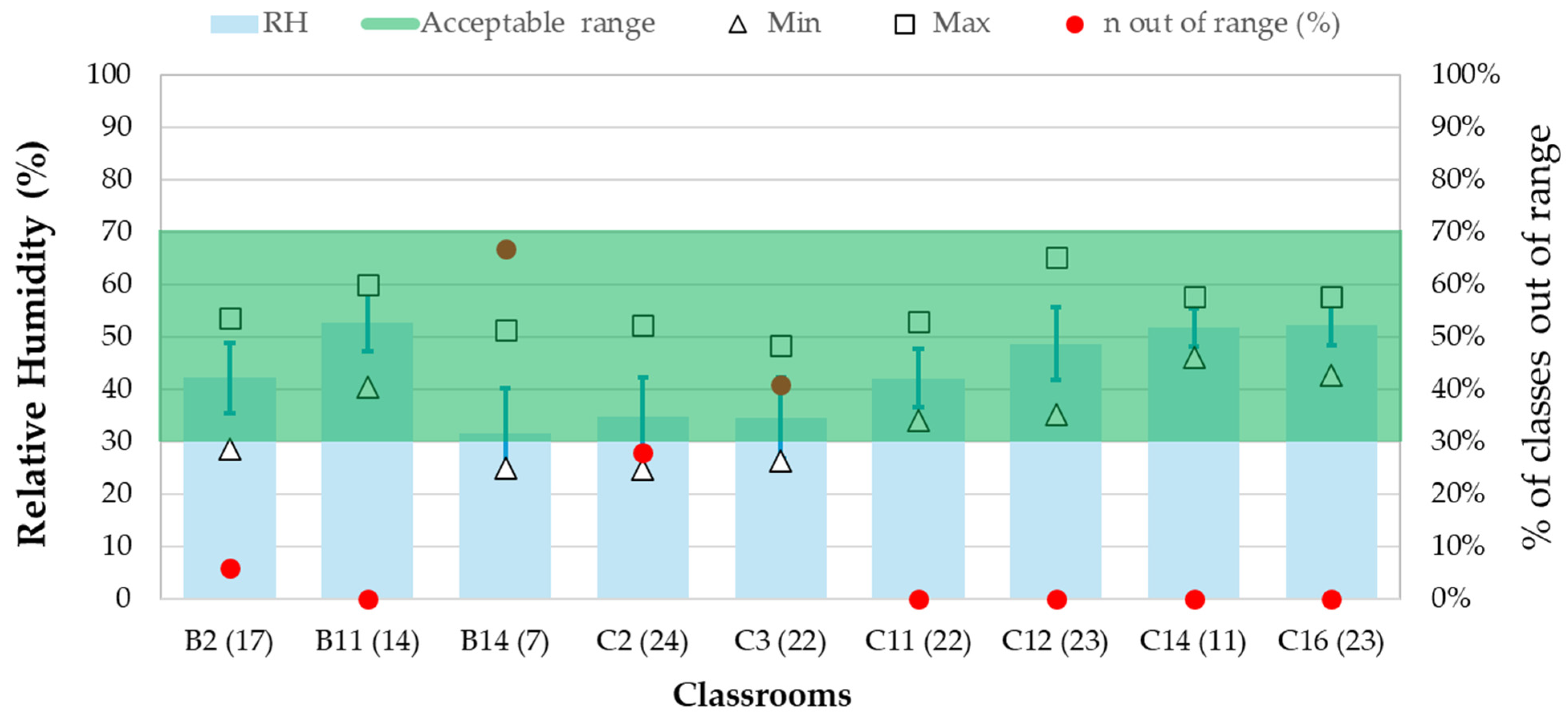

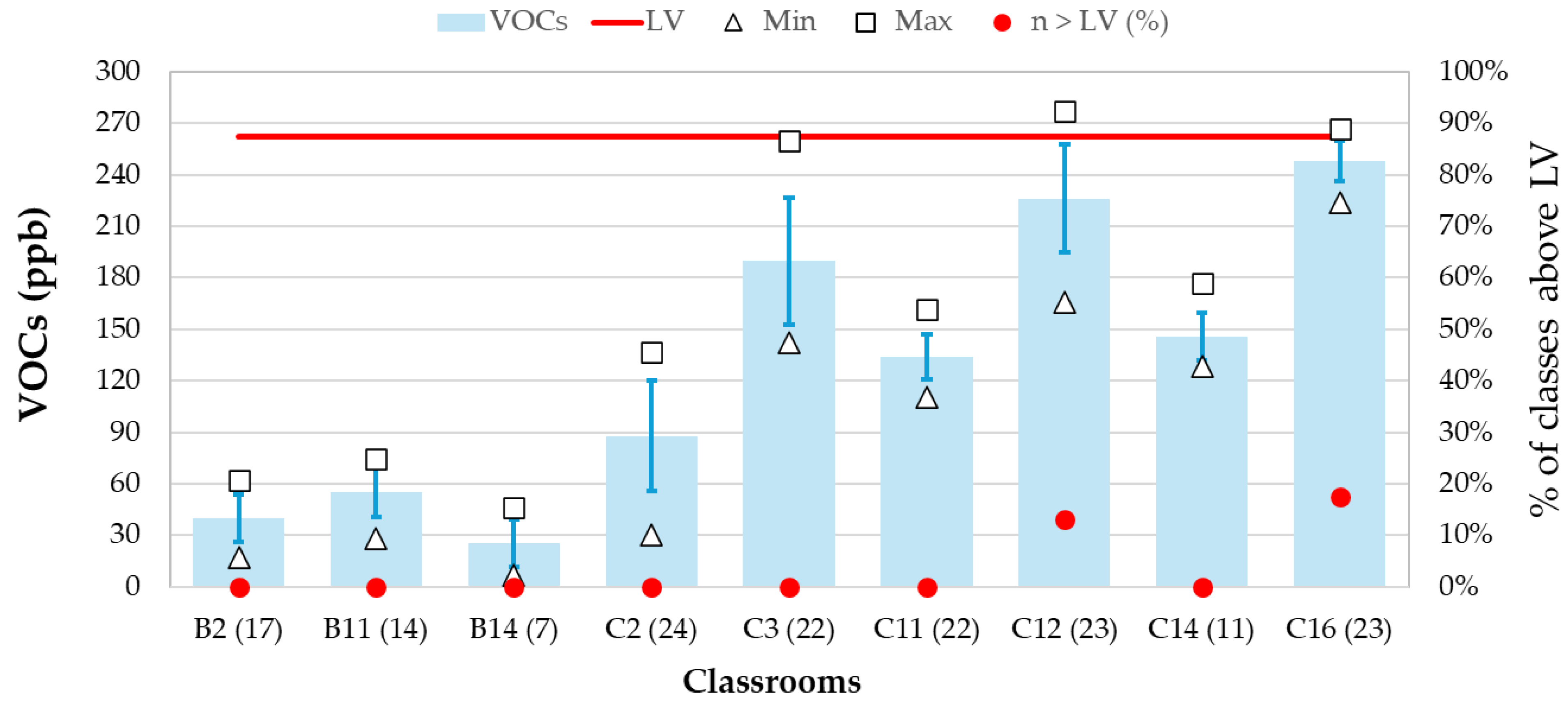
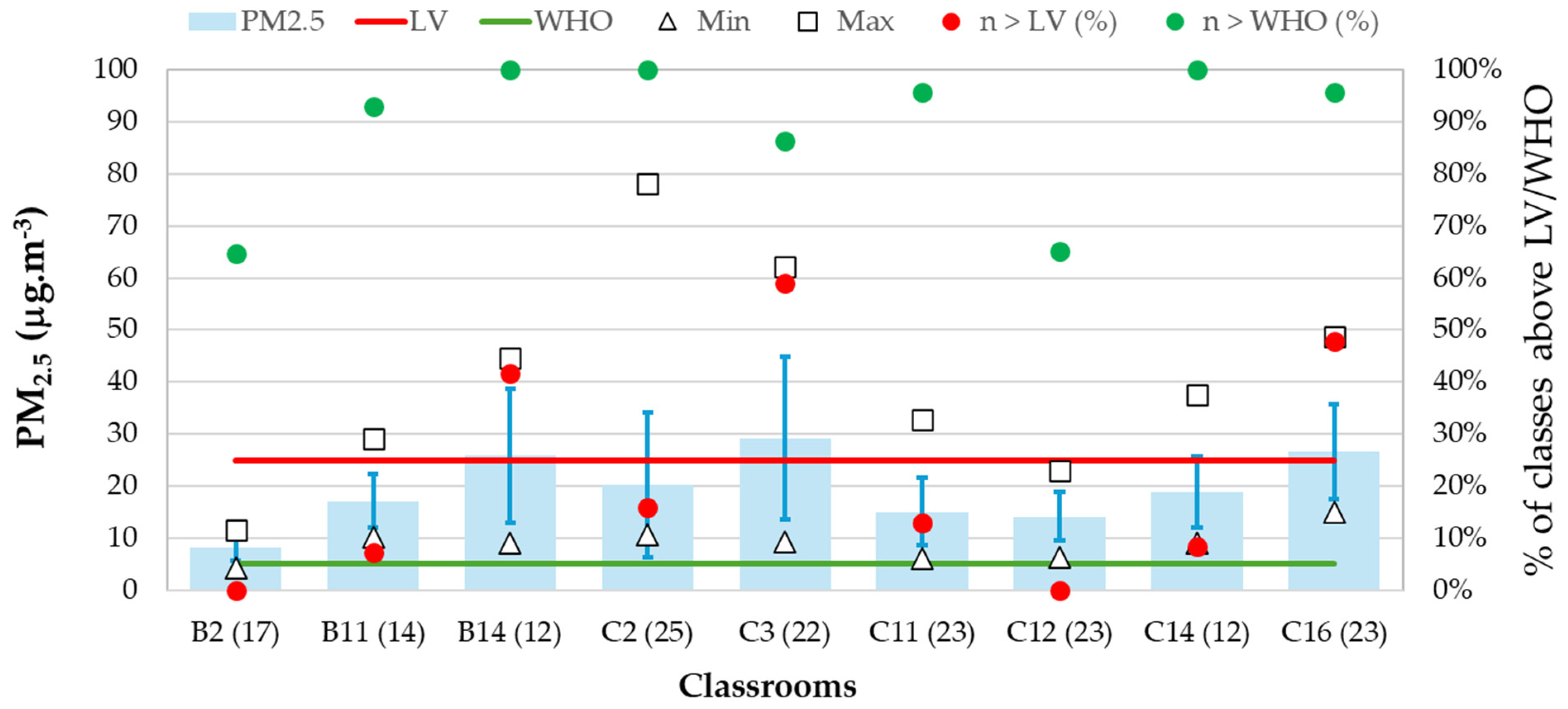
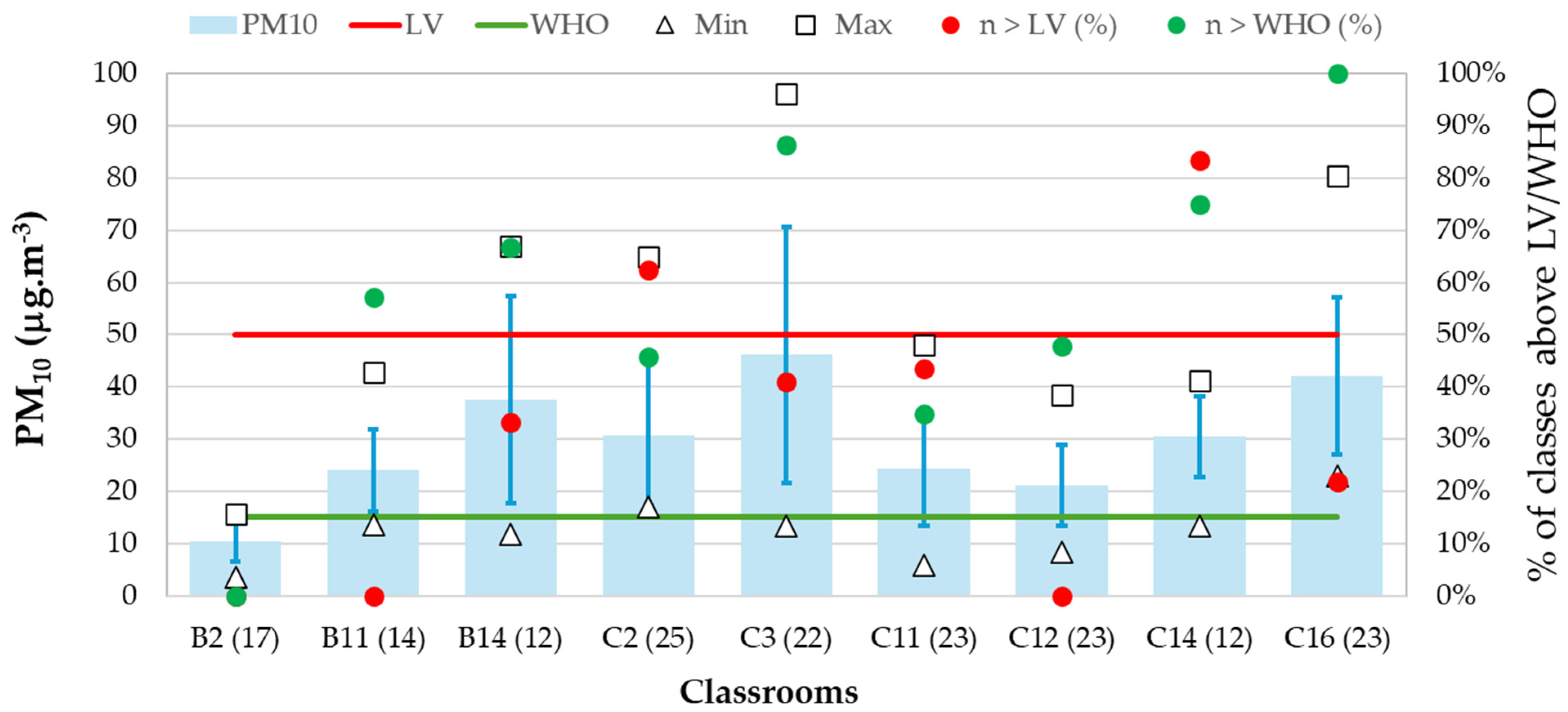
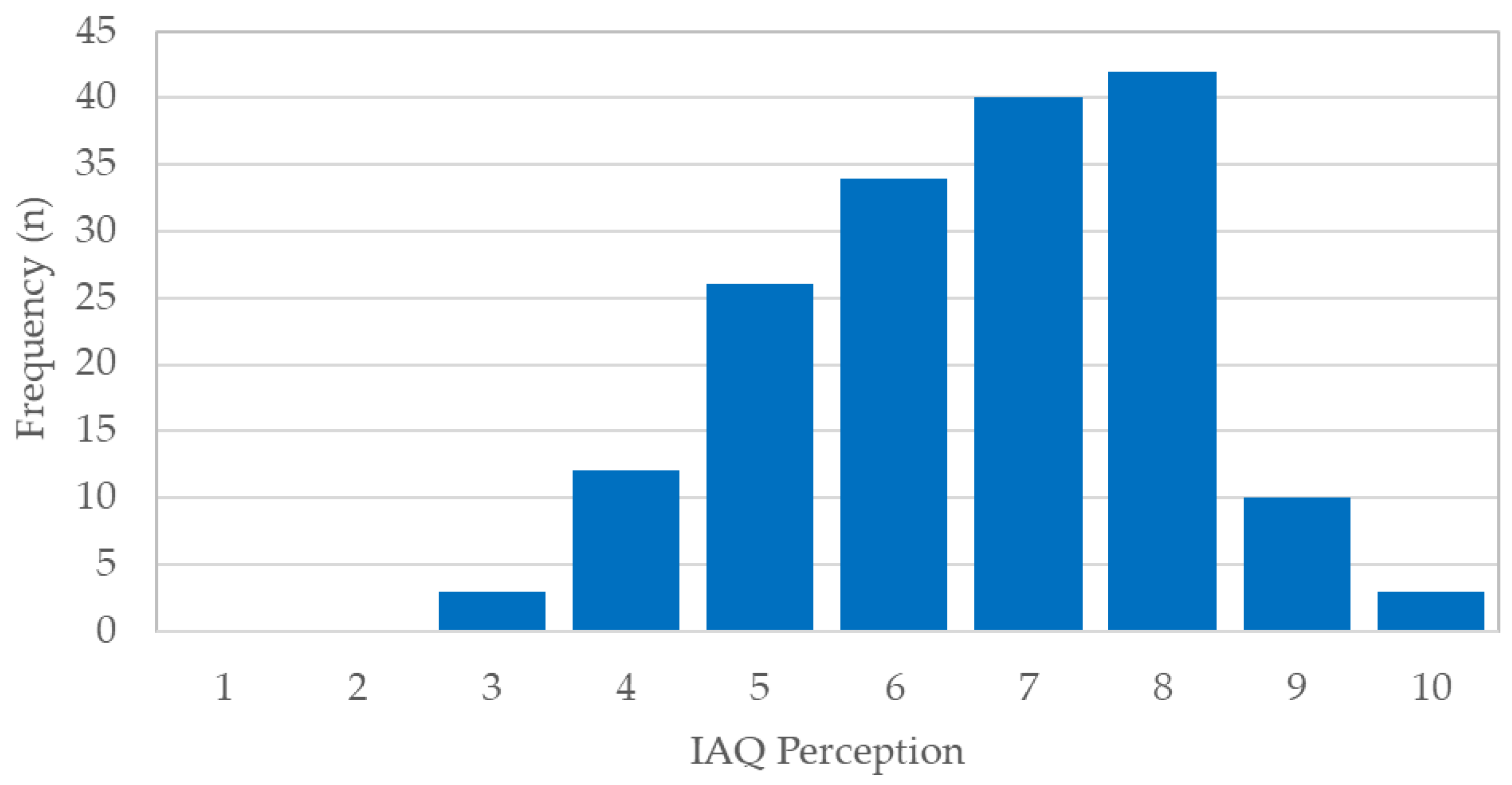
| Monitoring Unit | Parameter | Unit | m | b | R2 | RMSE | Frequency | Range CAL | n Points | Ratio MB/CAL |
|---|---|---|---|---|---|---|---|---|---|---|
| AirQ1 | PM2.5 | µg.m−3 | 2.193 | 1.006 | 0.673 | 4.0 | 5 min | 1.3–43.1 | 1005 | 0.37 |
| PM10 | µg.m−3 | 4.202 | −5.552 | 0.616 | 6.6 | 5 min | 1.7–102.9 | 1005 | 0.43 | |
| CO2 | ppm | 1.014 | −27.310 | 0.997 | 32 | 5 min | 400–2327 | 1530 | 1.02 | |
| VOCs | ppb | 0.320 | −67.074 | 0.443 | 462.4 | 5 min | 20–200 | 1290 | 5.05 | |
| T | °C | 1.284 | −10.431 | 0.861 | 3.1 | 5 min | 15.3–27.5 | 1493 | 1.13 | |
| RH | % | 1.164 | −3.232 | 0.908 | 4.4 | 5 min | 26.4–61.9 | 1530 | 1.09 | |
| AirQ2 | PM2.5 | µg.m−3 | 2.082 | 0.728 | 0.715 | 4.5 | 5 min | 1.3–43.1 | 1306 | 0.33 |
| PM10 | µg.m−3 | 3.527 | −4.685 | 0.975 | 25.6 | 5 min | 1.7–262.7 | 1102 | 0.42 | |
| CO2 | ppm | 0.992 | −23.907 | 0.997 | 39 | 5 min | 400–2327 | 1530 | 1.04 | |
| VOCs | ppb | 0.370 | −36.339 | 0.525 | 294.6 | 5 min | 63–183 | 1202 | 3.64 | |
| T | °C | 1.254 | −9.389 | 0.893 | 2.9 | 5 min | 15.3–27.5 | 1481 | 1.12 | |
| RH | % | 1.159 | −2.478 | 0.916 | 4.8 | 5 min | 26.4–61.9 | 1530 | 1.10 | |
| AirQ3 | PM2.5 | µg.m−3 | 1.755 | 0.698 | 0.719 | 3.9 | 5 min | 1.3–43.1 | 1110 | 0.50 |
| PM10 | µg.m−3 | 2.653 | −3.267 | 0.981 | 22.2 | 5 min | 1.7–262.7 | 1293 | 0.45 | |
| CO2 | ppm | 1.015 | −74.847 | 0.997 | 69 | 5 min | 400–2327 | 1528 | 1.09 | |
| VOCs | ppb | 0.315 | −97.282 | 0.417 | 562.5 | 5 min | 63–208 | 1174 | 5.91 | |
| T | °C | 1.260 | −9.611 | 0.902 | 3.0 | 5 min | 15.3–27.5 | 1416 | 1.12 | |
| RH | % | 1.234 | −6.860 | 0.895 | 4.2 | 5 min | 26.4–61.9 | 1528 | 1.07 |
| Classroom | Number of Evaluated Classes | Mean Number of Students per Studied Class | Mean Age of Students Attending Classes | Mean IAQ Perception of Teachers (1–10) |
|---|---|---|---|---|
| B2 | 17 | 16 | 16 | 8.1 |
| B11 | 14 | 23 | 16 | 5.4 |
| B14 | 12 | 16 | 16 | 5.7 |
| C2 | 25 | 13 | 17 | 7.2 |
| C3 | 22 | 19 | 16 | 6.6 |
| C11 | 23 | 14 | 14 | 5.3 |
| C12 | 23 | 15 | 16 | 7.7 |
| C14 | 12 | 19 | 18 | 7.3 |
| C16 | 23 | 19 | 16 | 6.1 |
| PM Concentration, Cj (µg.m−3) | Time, tj (h) | Exposure to PM (µg.m−3.h) | Potential Inhaled Dose (µg) | ||||
|---|---|---|---|---|---|---|---|
| Classroom | PM2.5 | PM10 | PM2.5 | PM10 | PM2.5 | PM10 | |
| B2 | 8.2 | 10.5 | 8.0 | 66 | 84 | 29.5 | 37.9 |
| B11 | 17.1 | 24.1 | 8.0 | 137 | 193 | 61.5 | 86.8 |
| B14 | 25.9 | 37.6 | 8.0 | 207 | 301 | 93.2 | 135.4 |
| C2 | 20.3 | 30.8 | 8.0 | 162 | 247 | 72.9 | 111.0 |
| C3 | 29.2 | 46.1 | 8.0 | 234 | 369 | 105.2 | 166.1 |
| C11 | 15.0 | 24.3 | 8.0 | 120 | 194 | 54.1 | 87.4 |
| C12 | 14.2 | 21.2 | 8.0 | 113 | 170 | 51.0 | 76.4 |
| C14 | 18.8 | 30.5 | 8.0 | 151 | 244 | 67.8 | 109.7 |
| C16 | 26.6 | 42.0 | 8.0 | 212 | 336 | 95.6 | 151.3 |
| Mean ± SD | 19.5 ± 6.8 | 29.7 ± 11.1 | 156 ± 54 | 238 ± 89 | 70.1 ± 24.4 | 107 ± 40 | |
| IAQ Perception | Temperature (°C) | Relative Humidity (%) | CO2 (ppm) | VOCs (ppb) | PM2.5 (μg.m−3) | PM10 (μg.m−3) |
|---|---|---|---|---|---|---|
| 1 | - | - | - | - | - | - |
| 2 | - | - | - | - | - | - |
| 3 | 27.7 ± 2.0 | 40.7 ± 10.1 | 1070 ± 350 | 167 ± 72 | 29.0 ± 3.2 | 45.1 ± 3.9 |
| 4 | 26.8 ± 2.6 | 46.4 ± 6.0 | 1030 ± 450 | 116 ± 60 | 13.0 ± 5.6 | 19.1 ± 8.8 |
| 5 | 26.0 ± 1.7 | 42.8 ± 10.3 | 1090 ± 410 | 136 ± 84 | 22.8 ± 14.5 | 32.0 ± 14.5 |
| 6 | 25.5 ± 1.7 | 41.2 ± 10.8 | 960 ± 300 | 139 ± 81 | 22.1 ± 12.2 | 34.2 ± 19.1 |
| 7 | 25.1 ± 1.7 | 45.1 ± 9.8 | 1180 ± 580 | 161 ± 68 | 21.1 ± 12.5 | 33.5 ± 19.5 |
| 8 | 25.3 ± 1.6 | 41.8 ± 9.6 | 970 ± 440 | 126 ± 88 | 17.3 ± 9.6 | 27.3 ± 17.2 |
| 9 | 25.4 ± 2.0 | 48.0 ± 6.7 | 1010 ± 430 | 178 ± 95 | 11.6 ± 5.1 | 17.0 ± 8.9 |
| 10 | 24.2 ± 0.7 | 36.5 ± 15.7 | 1000 ± 460 | 87 ± 60 | 17.6 ± 2.4 | 30.5 ± 4.5 |
| Environmental Parameters | |||||||
|---|---|---|---|---|---|---|---|
| Spearman Parameters | T | RH | CO2 | VOCs | PM2.5 | PM10 | |
| IAQ Perception | ρ | −0.225 | −0.001 | −0.073 | 0.031 | −0.146 | 0.119 |
| p-value | 0.003 | 0.991 | 0.346 | 0.689 | 0.057 | 0.122 | |
| n | 170 | 170 | 170 | 169 | 170 | 169 | |
| Environmental Parameters | ||||||
|---|---|---|---|---|---|---|
| Classrooms | T | RH | VOCs | CO2 | PM2.5 | PM10 |
| B2 | 35% | 6% | 0% | 29% | 0% | 0% |
| B11 | 43% | 0% | 0% | 36% | 7% | 0% |
| B14 | 50% | 67% | 0% | 8% | 42% | 33% |
| C2 | 40% | 28% | 0% | 8% | 16% | 63% |
| C3 | 36% | 41% | 0% | 14% | 59% | 41% |
| C11 | 87% | 0% | 0% | 26% | 13% | 43% |
| C12 | 43% | 0% | 13% | 39% | 0% | 0% |
| C14 | 42% | 0% | 0% | 42% | 8% | 83% |
| C16 | 35% | 0% | 17% | 43% | 48% | 22% |
| Mean exceedances | 46% | 16% | 3% | 27% | 21% | 32% |
Disclaimer/Publisher’s Note: The statements, opinions and data contained in all publications are solely those of the individual author(s) and contributor(s) and not of MDPI and/or the editor(s). MDPI and/or the editor(s) disclaim responsibility for any injury to people or property resulting from any ideas, methods, instructions or products referred to in the content. |
© 2024 by the authors. Licensee MDPI, Basel, Switzerland. This article is an open access article distributed under the terms and conditions of the Creative Commons Attribution (CC BY) license (https://creativecommons.org/licenses/by/4.0/).
Share and Cite
Canha, N.; Correia, C.; Mendez, S.; Gamelas, C.A.; Felizardo, M. Monitoring Indoor Air Quality in Classrooms Using Low-Cost Sensors: Does the Perception of Teachers Match Reality? Atmosphere 2024, 15, 1450. https://doi.org/10.3390/atmos15121450
Canha N, Correia C, Mendez S, Gamelas CA, Felizardo M. Monitoring Indoor Air Quality in Classrooms Using Low-Cost Sensors: Does the Perception of Teachers Match Reality? Atmosphere. 2024; 15(12):1450. https://doi.org/10.3390/atmos15121450
Chicago/Turabian StyleCanha, Nuno, Carolina Correia, Sergio Mendez, Carla A. Gamelas, and Miguel Felizardo. 2024. "Monitoring Indoor Air Quality in Classrooms Using Low-Cost Sensors: Does the Perception of Teachers Match Reality?" Atmosphere 15, no. 12: 1450. https://doi.org/10.3390/atmos15121450
APA StyleCanha, N., Correia, C., Mendez, S., Gamelas, C. A., & Felizardo, M. (2024). Monitoring Indoor Air Quality in Classrooms Using Low-Cost Sensors: Does the Perception of Teachers Match Reality? Atmosphere, 15(12), 1450. https://doi.org/10.3390/atmos15121450








